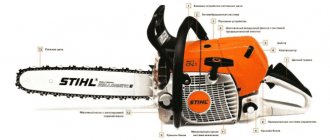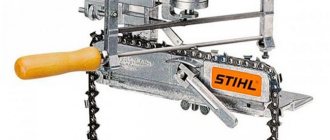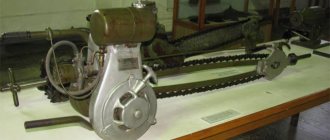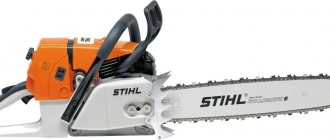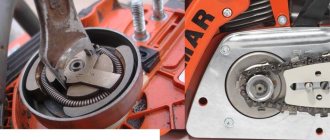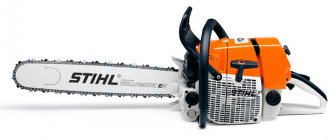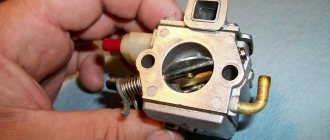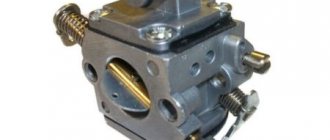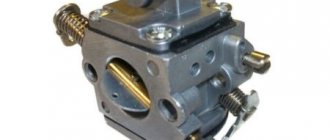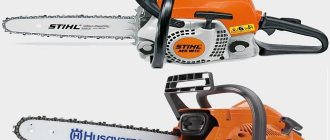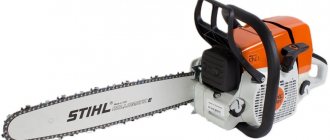Theory and principles of operation of the fuel system, carburetor design
The principle of operation of the carburetor
In different models of chainsaws, the design of the carburetor may differ, but the principle of operation of this part is always the same: the forced air flow moves in the direction of the air (pulse) channel, the air is regulated by the air damper.
Entering the pulse channel, the air changes speed. The change in speed is affected by a special valve that closes the air inlet. Fuel is supplied into the air channel and mixed with the air flow. As a result, a flammable fuel-air mixture is formed, which then enters the engine and burns there. Figure 1. Diagram of the operating principle of a chainsaw carburetor
Diagram of the operating principle of a chainsaw carburetor
Figure 2. Carburetor of the Husqvarna 137 chainsaw
Carburetor of Husqvarna 137 chainsaw
Figure 3. The principle of operation of the fuel system using the example of a chainsaw carburetor with a two-stroke engine
The principle of operation of the fuel system using the example of a chainsaw carburetor with a two-stroke engine
The components of any carburetor are:
- aluminum body (solid, cast);
- jets or valves that regulate the amount of fuel entering the carburetor;
- float chamber;
- diffuser;
- spray.
In Figure 1 you can see the location of the key components of the carburetor, and in Figure 2 you can see the appearance of the chainsaw carburetor. To properly adjust the carburetor, the chainsaw owner should know on what principle this part works:
- when the engine starts, the air damper opens;
- due to the stroke of the piston, rarefied air is formed inside the float chamber and in the air channel;
- then the mass of air is sucked through the diffuser, where it is mixed with fuel, which also passed through the fitting into the float chamber, thus creating a fuel-air mixture entering the intake channels;
- the last stage is the mixture entering the engine combustion chamber.
By adjusting the position of the damper, the chainsaw owner can either add air to the fuel or deplete it - this means that the fuel mixture will enter the combustion chamber faster or slower. Carburetor adjustment screws are used to adjust engine speed. An air filter is installed above the carburetor, which cleans the air before it enters the air duct.
Video showing a table for adjusting the carburetor of a Husqvarna chainsaw:
Figure 4. Table of proportions of oil-fuel mixture for Husqvarna chainsaws
Table of proportions of oil-fuel mixture for Husqvarna chainsaws
The carburetor unit of expensive and medium-cost chainsaws is designed almost identically. Cheap Chinese chainsaws often differ from expensive original chainsaw models in that they lack a number of parts in the carburetor unit. You can read about the features of adjusting the carburetor of Chinese chainsaws later in the article.
Step-by-step sequence of the adjustment process
Before you begin making adjustments, remember:
- the adjustment is carried out only “hot”, that is, the engine needs to be started and warmed up for 10 minutes;
- then the adjusting screw is turned counterclockwise and the chainsaw chain is stopped;
- before adjustment, the chainsaw must be placed on a flat surface, and the saw part must be directed away from the owner;
- for adjustment, three screws with letter designations are used, H - adjusts the upper speed, controls the main jet, L - adjusts the idle jet, adjusts the low speed, T - adjusts the idle speed.
Carburetor adjustment step by step:
- Scroll screw L from left to right, or from right to left, find the maximum engine speed, then return 1/4 turn back;
- do the same actions with screw H;
- the chainsaw should run for a few seconds, the maximum engine speed is determined using a tachometer - their indicator should not exceed the maximum specified in the instructions for the chainsaw;
- if the chain moves in idle mode, turn screw T in the direction of chain movement until the chain stops completely (idle speed is always adjusted only by screw T, which is rotated from right to left - counterclockwise - until the chain stops completely).
- the threaded fastener has weakened, air penetrates through the resulting gap;
- the jets are clogged with resinous deposits and need to be flushed with acetone;
- The ignition is not adjusted.
Carburetor design
In Fig. 1 shows a modern carburetor for a German-made Shtil 250 chainsaw. It is a unit the size of half a human fist. The manufacturer of the mechanism is Walbro, Taiwan. Case material – stainless steel alloy. A damper is attached to the bottom of the device, ensuring a uniform supply of the fuel-air mixture to the engine combustion chamber.
Rice. 1. Carburetor for the “Calm” chainsaw.
There are also holes for attaching the unit to the power unit housing. A sealing gasket is installed between the mixture supply flanges and the engine combustion chamber. The accelerator pump is located under the throttle rod. It is a small piston with a rubber ring.
On the front of the housing there is a series of easy-to-use spring-loaded adjustment screws:
- idle move;
- maximum speed;
- amount of mixture;
- quality of the mixture.
The carburetor of the Stihl chainsaw is adjusted using these screws.
The main innovative feature of the carburetor for the Shtil 250 chainsaw is the heating device. To avoid freezing of the mechanism when operating during the winter period, it is equipped with a special system that preheats the steel case during operation. To do this, the unit is switched to winter operating mode.
The housing is blown with heated air sucked from the engine. This mode of operation of the mechanism prevents icing and freezing of the jets, and ensures a normal supply of the fuel-air mixture. When switching to summer operation, the hot air damper closes. Summer mode is characterized by natural cooling of the unit.
Characteristics of the Shtil 250 chainsaw
Adjusting the Carburetor of the Stihl 250 Chainsaw with Your Own Hands
Do-it-yourself chainsaw carburetor adjustment
For an independent carburetor option, you need to familiarize yourself with its structure and understand the procedure for the work that is carried out to adjust the parts responsible for the proper functioning of the components of the device and parts close to it.
It is necessary to carefully handle items for the system option, and also to determine whether the set characteristics correspond to very acceptable values.
About the carburetor design
The carburetor is used to mix the combustible mixture with air while maintaining predetermined proportions. If clear doses are not followed, the proper operation of the engine is at risk. When a huge amount of air enters during mixing of the components, but there is not enough fuel, then such a mixture is considered “lean”.
Oversaturation should not be allowed, because with a larger amount of fuel compared to air, malfunctions or engine wear are also likely. DIY chainsaw repair Shtil 180 - 142, 240, 365 - video. Carburetor adjustment is needed not only before initial use, but also when any differences in its operation are detected. Before working with a chainsaw, do not forget to run it in.
Carburetor components
The carburetor design contains a standard set of parts, but may vary slightly depending on the manufacturer. Components:
- The basis. Adjusting the carburetor with your own hands. This is a special tube that is visually similar to an aerodynamic design. Air passes through it. In the transverse direction, a damper is located in the middle of the pipe. Its position can be changed. The more it is extended into the passage, the less air enters the engine.
- Diffuser. This is the constricted part of the tube. With its help, the air supply speed increases precisely in the segment from which the fuel comes out.
- Channels for fuel supply. The fuel mixture is contained in the float chamber, then passes into the nozzle, from which it flows into the atomizer.
- Float chamber. It is a separate structural element, reminiscent of the shape of a tank. Designed to constantly maintain the optimal level of fuel fluid before entering the channel from which air enters.
Don't know which chainsaw to choose? Read our article.
Are you looking for cheaper models, but reliable and time-tested? Pay attention to Russian-made chainsaws. Or explore foreign chainsaw manufacturers such as Shtil
Or explore foreign chainsaw manufacturers such as Shtil.
Reference!
A chainsaw carburetor is a part of a chainsaw fuel system designed to mix gasoline with air and distribute the supply of this fuel mixture to the engine cylinder.
Note: gasoline with air in a ratio of 1:14, i.e. 1 part gasoline and oil is mixed with 14 parts air, and adjusting the chainsaw carburetor ensures the correct ratio of these components of the fuel mixture.
The carburetor of any chainsaw sooner or later requires adjustment; the procedure is necessary for several reasons. For example, a chainsaw stalls during operation or does not start at all. Simple cleaning and adjustment may solve the problem. The Stihl 250 chainsaw has a fairly standard carburetor, so the setup procedure will be simple. Let's look at the whole process in detail.
When should you clean your carburetor?
This is determined by the condition of your spark plug; in normal condition, the electrodes should be a brick-gray shade. A detuned carburetor will show a black spark plug (rich mixture) or a spark plug that is too white (lean mixture).
The design of the Shtil 250 carburetor assumes the location of the main screw on the muffler side; this is the screw that regulates the quality of the mixture. Typically, the store sells a chainsaw with the screw unscrewed by 1 turn, this is considered the norm until a certain period of operation. To make the mixture rich, you will have to unscrew the screw a little; the mixture will become lean when you tighten the screw. Enrichment of the mixture in the carburetor of a chainsaw indicates a greater supply of fuel to the carburetor, while less air is supplied. A lean mixture is characterized by the reverse process.
Be sure to look at the review of the Stihl MS 250 chainsaw, because you can adjust the carburetor only after studying this model.
How to flush a chainsaw carburetor?
Carburetor contamination occurs for many reasons, such as the presence of ethanol in gasoline, the use of dirty or poor quality fuel. And contamination, in turn, makes it difficult to start the engine and leads to interruptions in operation and various malfunctions. By following these steps, you can flush the carburetor yourself and troubleshoot problems:
Prepare your workplace. Clean the outside of the engine from contamination. Remove the cover from the filter, take out the filter itself and remove the housing from it. Unscrew the fasteners securing the carburetor and engine. Before disconnecting the traction and throttle cables, remember their position, as you will have to put them back in place later. Remove the fuel hoses using pliers. When removing the carburetor from the studs, you must act carefully so as not to damage the integrity of the gasket. Clean the carburetor using a synthetic brush. You must act carefully so that debris does not get inside the device. Unscrew the fasteners on the diaphragm cover and remove it
Then remove the diaphragm and clean it from contamination. After putting things in order, put the lid back in place. Remove the fuel filter. Clean it or replace it. Clean the fuel supply points. Clean the fittings. Clean all parts using the blowing method. Reassemble all parts in reverse order. Turn on the engine, adjust the carburetor and check the operation of the chainsaw.
Do-it-yourself adjustment of the Stihl MS 361 chainsaw carburetor
The three adjustment screws are primarily for factory adjustment. After assembling the carburetor and saw, each of them is adjusted one by one, on special stands, taking into account the characteristics of each Stihl MS 361 chainsaw. The screws are securely fixed during operation and do not unscrew spontaneously. Adjustment is rarely required. Namely:
- When the piston system is critically worn, when the compression ratio (compression) has changed significantly.
- When replacing the piston system, when the chainsaw does not work as well as during factory settings.
- When working in the mountains, where due to low atmospheric pressure the engine lacks oxygen and it is necessary to increase the air supply (lean the mixture).
In other cases, idle speed adjustment is most often required if the engine stalls in this mode.
Required Tools
A special feature of the Stihl MS 361 chainsaw is easy access to the carburetor. Simply remove the cover and air cleaner. Therefore, no tool other than a screwdriver is needed for adjustment. For professional adjustment you will need a tachometer. It will show the number of idle and maximum revolutions. Correct adjustment should provide 2500 rpm at idle and 10,000 rpm at maximum speed.
In the absence of a tachometer, the maximum speed is determined by ear. Idle - within two limits: the chainsaw should not stall when the idle speed is low, the chain should not move when the speed is too high.
The tachometer allows you to more accurately adjust the maximum and minimum speed of the chainsaw
Step-by-step adjustment algorithm
Before adjusting, you need to make sure that the air filter is clean. If it is clogged, there may not be enough air for complete combustion of the fuel mixture. Therefore, the engine does not work correctly. Perhaps no adjustment is required, but the filter needs to be cleaned or replaced.
Remove the filter and try how the engine works without it. If good, then the problem is in the filter.
The presence of carbon deposits in the spark arrester grille and muffler is also checked. If the exhaust gases are obstructed, the engine is also not working properly and the problem is not the carburetor setting.
Standard adjustment
The manufacturer of the Stihl MS 361 chainsaw in the Operation Manual (p. 37) recommends the following carburetor adjustment algorithm:
- Turn the high speed adjusting bolt H clockwise until it stops, but no more than 3/4 of a turn.
- Tighten the idle speed adjusting bolt L clockwise until it stops. Then turn it counterclockwise 1/4 turn.
- Start the engine and warm up for 7-10 minutes.
- Then the idle speed is adjusted by adjusting the LA thrust screw while the engine is running. It is screwed in clockwise, increasing idle speed until the chain begins to move. Then the LA screw is unscrewed back 1/2 turn.
- If, when adjusting with screw LA, it is not possible to correctly adjust the idle speed (the engine stalls or the chain spins), they are adjusted with screw L. It is unscrewed 1/4 turn. Then continue adjusting with the LA screw, unscrewing it counterclockwise until the chain stops. Then in the same direction about 1/2 more turn. But so that the engine does not stall at idle.
In addition to the manufacturer's recommendations, there are practical aspects of carburetor adjustment.
Adjusting screws for the carburetor of the Shtil MS 361 chainsaw
Nuances you need to know
Turning any screw changes the factory setting
Therefore, it is extremely important to remember or write down the number of turns by which the position of the screws changed during adjustment. For example, if the screw is tightened all the way, it must be tightened, be sure to count the revolutions
Only this will make it possible to return to the factory adjustment parameters if it turns out to be unsuccessful.
Adjusting high speeds is easiest when the engine is running. Screw H is turned in small steps by 1/4 - 1/2 turn in one direction or the other. By pressing the throttle, you try how the engine reacts to changes in settings. Changes in speed are determined by ear or using a tachometer.
After adjusting high speeds, it is most often necessary to adjust the idle speed adjustment.
Educational video
The author of the video shows an example of original Chinese-made carburetors that are used on Stihl MS 361 chainsaws – Zam. He compares it with the German Walbro carburetor. He also gives an example of a fake carburetor. The video is very useful, recommended for viewing by both beginners and experienced people. We thought the problem was in the carburetor, but it turned out that it had nothing to do with it, it was much more serious.
Trimmers and chainsaws
The need for the operation “Adjusting the chainsaw carburetor” is determined by the color of the spark plug electrodes: if they are black, it means over-enrichment, if they are brick-gray, then it is normal, if there is a white coating on the electrodes of the spark plug, it means the mixture is lean. The main role in adjusting the carburetor of the Stihl chainsaw is played by the upper screw (closest to the muffler). According to the factory parameters (indicated on the cover of the chainsaw), it should be unscrewed 1 turn, and then it needs to be adjusted - if you unscrew it, the working mixture becomes richer (more gasoline gets into the air-fuel mixture), if this screw is screwed in, the working mixture becomes leaner (less gasoline gets into the air-fuel mixture).
Dismantling the Shtil 180 carburetor
In order to blow, change gaskets or needle valve, the carburetor must be disassembled. To do this, you need to unscrew 4 screws on the compensator cover and one on the fuel pump.
Once you open the housing, you should be extremely careful, because if debris gets inside the carburetor, it will make it impossible to operate. The thickness of the channels in it is comparable to the thickness of a thread or even a human hair.
A video on repairing a Shtil 180 carburetor can be viewed below. In it, the master talks in detail about the problems and clearly demonstrates the entire repair process.
Possible faults
If the saw does not start, the first thing you need to check is the spark plug, which gives a spark, which ignites the fuel in the cylinder. Start by removing the high voltage wire that the spark plug is connected to. Then unscrew the spark plug itself from the cylinder cover and inspect its condition. When working properly, the candle should be dry and have small deposits on the ceramic of a light color:
- If the spark plug is wet, it means there are problems with the carburetor. It is necessary to adjust and set the fuel level in it;
- Soot on the walls of the spark plug is dark or black in color, indicating a malfunction in the piston group.
Repairing the carburetor of the Shtil 180 chainsaw
The main malfunctions of the Shtil 180 chainsaw carburetor include the following.
Gasoline does not flow into the carburetor. The banal reason is fuel pump failure. The diaphragm has lost elasticity or become thin. This happens due to fatigue of the material after prolonged use. As a result, when there is a vacuum in the engine, the diaphragm does not rise and does not open the fuel channel with the valve. It can be replaced with a spare one from the repair kit by disassembling the carburetor. Gasoline may also not flow due to a clogged filter element (mesh) in the channel between the fuel pump and the needle valve. It can also be treated by replacing it from the repair kit. The carburetor is overflowing. It is not difficult to guess that the problem lies in the main camera. Dirt particles fall into the cavity between the needle and the channel, i.e. the valve does not completely close the channel when needed and the chamber floods. Very often the membrane ceases to perform its functions due to stretching (natural wear). As a result, when lowered, the membrane does not fully lift the needle, and fuel continues to flow. The main membrane is also included in the repair kit. Replacing it won't be difficult. Very often, after winter downtime, owners of Shtil 180 chainsaws encounter difficult starting. In this case, the valve in the nozzle is stuck. The manufacturer recommends that before storing the chainsaw, burn off the remaining gasoline in the carburetor. Gasoline is prone to evaporation and during long-term storage, engine oil remains in the carburetor, upon contact with which the injector valve begins to stick to the body. As a result, fuel does not enter the diffuser. Since the nozzle is not included in the repair kit, you have to knock it out and wash it thoroughly
This must be done very carefully. If the idle jet or injector is clogged, it is enough to blow them out with compressed air. Or wash it in gasoline, in 90% of cases this helps
But you cannot use needles or wires, because... there is a risk of changing the flow area, thereby changing the throughput of the jets.
So, you decided to remove the carburetor and carry out diagnostics. The removal procedure is as follows:
- Press the gas trigger and lower the choke lever down. Turn the latch and remove the chainsaw cover.
- Using a socket wrench 8, unscrew both fastening nuts and remove the air filter with the housing.
- Remove the gas draft (throttle valve) of the carburetor.
- Disconnect the cable from the control lever
- We remove the engine control lever from its place. At the same time, disconnect the air damper rod.
- Pull the carburetor towards you and remove it from the studs. Don't forget to disconnect the fuel supply hose.
A more detailed and visual algorithm for removing a carburetor from a chainsaw is presented in the video.
As for disassembling the carburetor of the Shtil 180 chainsaw, everything is simple. 1 bolt is unscrewed on the fuel pump cover and 4 bolts on the main chamber cover. This is enough to change all the necessary components from the repair kit.
After disassembly, the carburetor must be washed in gasoline, and the channels and jets must be blown out with compressed air. Under no circumstances should the carburetor be blown under high pressure and in the assembled state. Otherwise you may stretch the membrane or diaphragm. The carburetor will stop working properly.
In order to assess the condition of the filter mesh and membrane, you need to perform the following sequence of actions:
- Unscrew the screw.
- We assess the condition of the membranes, remove dust and dirt, and if necessary, replace the membrane with a new one. Everything under the membrane should be clean. There should also be no dirt on the membrane.
We check the condition of the filter mesh for dirt and clean it if there is any.
We put everything back together and disassemble the carburetor on the other side. After unscrewing the 4 bolts, remove the cover, remove the membrane and assess the condition of the insides. A total of 4 screws need to be unscrewed
To check the serviceability of the fuel supply, put the hose on the fitting.
We blow into it with our mouth, while using our fingers to open the needle valve, everything should work correctly.
We blow out 2 holes in the jets with the same hose, they should blow easily, without excessive force. If necessary, simply clean with regular WD-40 cleaner.
We remove the nozzle located on the right and clean it with a thin wire from the reverse side.
We clean and collect everything. When installing the cover, ensure correct installation. See photo below.
As for the repair kit for the Shtil 180 carburetor, it includes a set of gaskets for the covers, a diaphragm and membrane, a needle valve, a rocker arm with an axle and a spring. The price of such a kit is from 100 to 400 rubles.
Model specifications
The advantages of this household garden tool include good factory parameters, which allow the model to be used for work under increased loads.
The main characteristics of the chainsaw include:
- engine power – 2.7 liters. s./2 kW;
- cylinder volume – 40.2 cm3;
- idle/maximum speed – 2800/10000 rpm;
- permissible length of the installed tire is 30–35 cm;
- the recommended pitch of the chain used is 3/8 “;
- vibration right/left – 6.9/8.9 m/s2;
- noise level during operation – 113 dB.
The Stihl MS 230 C BE 16 chainsaw has a modest weight - with full tanks and an installed saw set, the model weighs 4.6 kg.
Adjustment
When purchasing a new chainsaw, the Stihl MS 250 carburetor does not require adjustment - everything is set up from the factory and ready to go! It is required only after a certain period of operation, as a result of which its parts have worn out or broken.
When to adjust?
The first sign that the carburetor needs to be cleaned and adjusted is black (rich mixture) or very light (lean mixture) carbon deposits on the glow plug. With normal adjustments, an optimal ratio of gasoline to oil and a correctly adjusted fuel supply to the internal combustion chamber, the soot on the spark plug will be gray-brick.
Required Tools
To adjust, you will need a tool that everyone has: a set of screwdrivers, a set of open-end wrenches.
The materials you will need are rags and kerosene (gasoline) for washing parts.
Tachometer – for precise adjustment of carburetor speed. This is an important thing, but you can do without it.
Preparation
Before adjusting the carburetor, perform preventive maintenance of the unit:
- The air filter is cleaned;
- The entire carburetor is cleaned;
- The engine is cleaned and washed from dust and dirt;
- The circuit is being adjusted;
- The spark plug is cleaned or replaced.
Setup instructions
Step-by-step algorithm for adjusting the Zama C1Q-S85 carburetor on a Stihl MS 250 chainsaw:
- After stopping the engine, it is necessary to completely tighten the screws “H” and “L”, and then unscrew each one full turn.
- Next, you should start the engine - the chainsaw should idle for 5-10 minutes.
- By adjusting screw “H” you need to achieve maximum engine speed (14,000 rpm) with the throttle fully depressed. To accurately determine engine speed, use a chainsaw tachometer. If it is not there, the adjustment should be made by ear - you need to set the maximum speed and then reduce it by about 20-25%.
- Using the “LA” screw, you need to adjust the idle speed so that the chain on the bar rotates slightly, and then you need to unscrew the “LA” screw 1/4 turn.
- If the chainsaw stalls or the speed constantly changes, you need to unscrew the “L” screw, and the engine speed should increase.
- Next, use the “LA” screw to set the optimal engine idle speed, while the Stihl MS 250 should operate at 2600 rpm. This is idle speed.
If the carburetor or cylinder is sucking air, these procedures may not help. Air can enter the engine through a leaky carburetor gasket, crankshaft seals, or accelerator pump.
How to fix this problem, see the video below; the author also talks about adjusting the Zama C1Q-S85 carburetor. In the example, the chainsaw does not start well and stalls during operation.
Setup video
We also suggest you watch another interesting video, the author of which clearly shows how to adjust the carburetor on a Stihl MS 250 chainsaw.
Basic configuration, equipment, country of assembly and production
List of elements of the basic configuration of the Shtil 250-ms model:
- saw chain, bar;
- tire cover;
- universal key;
- body part of the chainsaw;
- instructions;
- warranty document;
- factory packaging - cardboard box with documentation and product.
If necessary, the owner of the Shtil 250-ms chainsaw can purchase, in addition to the technical product, such accessories as:
- branded chain;
- Stihl engine oil for chain and bar lubrication.
The country of assembly and production of the Shtil 250-ms chainsaw is the USA. The homeland of the brand is Germany. Like other Stihl chainsaws, Chinese copies are often produced for this model, and counterfeits have their share of popularity among buyers, since they cost three times less than the original. Chinese copies of Stihl saws are equipped with a weaker carburetor; according to reviews from buyers of such units, after a couple of weeks of use, chainsaws require repairs, and some models often stall, and then completely stop starting.
Video on how to distinguish an original Stihl saw from a fake:
Preparation for tuning, carburetor parts for its implementation and safety precautions
Before adjusting the UPT, you must make sure that both filters (air and fuel) are clean. In addition, there should be no air leakage into the engine from the side (through the seals, the gasket under the UPT or its accelerator pump, or anywhere else), otherwise it will not be possible to adjust the carburetor.
Preparing to adjust the carburetor
Almost any UPT is adjusted with 3 screws:
- The main jet bolt, designated "H" and used to set the maximum speed of the saw motor.
- The idle jet bolt, designated "L" and used to set low speed. That is, to regulate idle speed.
- The idle adjustment bolt, designated in various cases, “LA” (Stihl), “T” (Partner, Husqvarna).
There are also carburetors with fewer adjustment screws. In this way, manufacturers protect their products from unprofessional intervention and at the same time try to simplify their setup.
For safe regulation during its implementation, the following rules should be followed:
- The tool must be firmly installed on a flat surface of a rigidly fixed object (workbench, rack, table).
- The chain should be directed away from yourself and others present.
- There must be a safe distance between the chain and any surrounding objects to ensure that they cannot come into contact.
Specifications
The Stihl MS-660 professional chainsaw is equipped with a fifty-one cm variable bar and a spare chain. Replacing parts is quick, which makes it possible to work with thick trunks and then cut out branches.
The Chinese chainsaw has the following characteristics:
- Power 7.1 hp (5.22 kW)
- Engine capacity 91.6 cm³;
- Chain saw pitch nine mm;
- Chain thickness 1.6 cm;
- Number of links in chains 72, 90, 162;
- Fuel consumption 0.4-0.8 l/h;
- Fuel tank capacity 0.83 l
- Oil tank capacity 0.36 l
- Tire length 40, 50, ninety cm;
- Weight fully charged 7.3 kg.
Specifications may vary slightly as manufacturers make changes and modifications to their products.
Weekly chainsaw maintenance.
Checking the spark plug Clean and check the gap (0.4-0.5 mm).
Make sure the surfaces around the electrode are clean. Use a suitable tool for the spark plug and gauge plate. Do not rub the spark plug.
Starter mechanism Remove and clean. Lubricate the spring with very thin oil. Replace the cable if it is damaged.
Drive gear bearing Remove the gear wheel. Clean and lubricate the axle and bearing. Check gear wear.
Clean the flywheel and cooling fins with a screwdriver or a pointed stick. Clean the ribs.
Tire Use a file to remove any burrs on the sidewalls of the tire. Check the sprocket travel at the end of the bar. Check tire alignment and wear.
Chain Check the wear of the cutting links, as well as the rivets for breaks or cracks. Sharpen if necessary. Adjust the height of the depth stops.
Preparation for self-tuning of fuel equipment
The sequence for adjusting the carburetor is outlined in the attached operating instructions. The factory kit includes a screwdriver for adjusting the screws marked with the letters L, H and T. Some manufacturers equip their chainsaws with carburetors, the adjustment of which requires a special adjustment key.
Read also: How to solder wires together with a soldering iron
Correct tuning of the fuel system requires warming up the power unit to operating temperature and pre-cleaning the air intake filter element. The saw is installed in a position that provides convenient access to the fuel equipment.
Reference!
Adjusting the chain carburetor Calmness may be required when the quality of the fuel changes, the height above which the chainsaw operates (air rarefaction), as well as when atmospheric pressure, temperature and air humidity change. Adjusting the chainsaw carburetor
allows you to achieve excellent chainsaw performance with deteriorating external operating conditions. Additionally, adjusting your carburetor chainsaw can prevent oil depletion and engine breakdown due to insufficient lubrication entering the lean cylinder.

